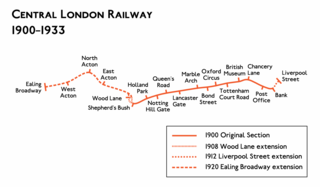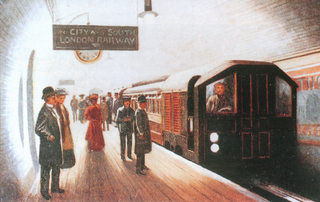Related Research Articles

The Central line is a London Underground line that runs through central London, from Epping, Essex, in the north-east to Ealing Broadway and West Ruislip in west London. Printed in red on the Tube map, the line serves 49 stations over 46 miles (74 km). It is one of only two lines on the Underground network to cross the Greater London boundary, the other being the Metropolitan line. One of London's deep-level railways, Central line trains are smaller than those on British main lines.
Valleys & Cardiff Local Routes is the network of passenger suburban railway services radiating from Cardiff, Wales. It includes lines within the city itself, the Vale of Glamorgan and the South Wales Valleys.

Holborn is a London Underground station in Holborn, Central London, located at the junction of High Holborn and Kingsway. It is served by the Central and Piccadilly lines. On the Central line the station is between Tottenham Court Road and Chancery Lane stations; on the Piccadilly line it is between Covent Garden and Russell Square and is in Travelcard Zone 1. Close by are the British Museum, Lincoln's Inn Fields, Red Lion Square, Bloomsbury Square, London School of Economics and Sir John Soane's Museum.

Willesden Junction is a railway station in Harlesden, north-west London, UK. It is served by both London Overground and London Underground services.

Barking is an interchange station serving the town of Barking, east London. It is served by London Underground, London Overground and National Rail main line services. It is located on Station Parade, in the town centre.

The London, Tilbury and Southend line, also known as Essex Thameside, is a commuter railway line on the British railway system. It connects Fenchurch Street station, in central London, with destinations in east London and Essex, including Barking, Upminster, Basildon, Grays, Tilbury, Southend and Shoeburyness.

The Weka Pass Railway is a New Zealand heritage railway based in Waipara, North Canterbury. It is operated on a 12.8 km length of the former Waiau Branch railway between Waipara and Waikari. The railway is operated by an incorporated society whose members come from all walks of life and are largely resident in the city of Christchurch, 60 km to the south. The railway began carrying passengers in 1984 and is now well established locally and nationally.

The Lincolnshire Wolds Railway (LWR) is a heritage railway based at Ludborough station, near Louth, Lincolnshire, England and the only standard gauge steam railway in Lincolnshire open to the public. The line is part of the original Great Northern Railway (GNR), a rail system that opened in 1848 and once linked Grimsby, Louth and East Lincolnshire with London. In early 2002, 2009 and 2013 the Lincolnshire Wolds Railway received a top national award from the Heritage Railway Association for its heritage railway efforts.

From 1839 the Trustees of the Marquis of Bute, operated a large dock operation in Cardiff, the "Bute Docks". This was very successful, but was overwhelmed by the huge volume of coal exported through Cardiff. At the same time it was seen that railway companies, especially the Taff Vale Railway (TVR), were making money conveying the coal to the docks.

The Central London Railway (CLR), also known as the Twopenny Tube, was a deep-level, underground "tube" railway that opened in London in 1900. The CLR's tunnels and stations form the central section of the London Underground's Central line.

The Royal Deeside Railway is a Scottish heritage railway. It was formed in 1996 by a group of volunteers with the intention of reclaiming part of the former branch line from Aberdeen to Ballater. Originally constructed between 1853 and 1856 by the Deeside Railway Company, the line was regularly patronised by the Royal Family and other VIP visitors to Balmoral. However due to its dwindling numbers the line was eventually closed by British Railways in 1966. After many years of hard work by dedicated volunteers, the first ever steam-hauled passenger services on the newly reclaimed line were operated in 2010.

Radyr railway station is a railway station serving the Radyr area of Cardiff, South Wales. It is at the foot of the hill at the eastern edge of the village, alongside the River Taff and adjacent to the Taff Trail. The station is on the Merthyr Line, and is also the northern terminus of the City Line.

The South Eastern and Chatham Railway (SECR) C Class is a class of 0-6-0 steam locomotive, designed by Harry Wainwright and built between 1900 and 1908. They were designed for freight duties, although occasionally used for passenger trains. They operated over the lines of the railway in London and south-east England until the early 1960s. One example was rebuilt as an S Class saddle tank.

The Central London Railway Stock were electric multiple units composed of trailers that had been converted from carriages designed to be hauled by electric locomotives with new motor cars. The Central London Railway opened in 1900 with electric locomotives hauling wooden carriages, but the heavy locomotives caused vibrations that could be felt in the buildings above the route. Following investigation it was found that conversion to electric multiple units solved the problem, so new motor cars were bought and replaced all the locomotives by June 1903. Trains normally ran with six-cars, four trailers and two motor-cars, although some trailers were equipped with control equipment to allow trains to be formed with three cars.

The Corringham Light Railway (CLR) in Corringham, Essex, England was incorporated on 10 July 1899 and opened to freight on 1 January 1901, to passengers on 22 June 1901. It closed to passengers on 1 March 1952 and was absorbed into the Mobil Oil Company on 20 September 1971. The railway itself went from an end on junction with the London Tilbury and Southend Railway at Thames Haven to both Corringham and Kynochtown.

Coryton Refinery was an oil refinery in Essex, England, on the estuary of the River Thames 28 miles (45 km) from central London, between Shell Haven Creek and Hole Haven Creek, which separates Canvey Island from the mainland.

Shell Haven was a port on the north bank of the Thames Estuary at the eastern end of Thurrock, Essex, England and then an oil refinery. The refinery closed in 1999 and the site was purchased by DP World who received planning consent in May 2007 for the new London Gateway deep water container port at the site. The neighbouring Coryton Refinery remained in operation until 2012.
Corringham railway station served the villages of Corringham and Fobbing in Essex, England, between 1901 and 1952.
Coryton railway station served the village of Kynochtown and the Coryton Refinery in Essex, England, between 1901 and 1952.
Thames Haven Railway Station is a freight terminal on the coast of Essex, England. It is the terminus of the goods-only Thames Haven branch.
References
- ↑ Scott, W. Coryton, The History of a Village. Mobil. 1981. p. 42
- ↑ Kay, P. The Corringham Light Railway, A New History. 2008. p.86
- ↑ Kay, P. The Corringham Light Railway, A New History. 2008. p.90
- ↑ Kay, P. The Corringham Light Railway, A New History. 2008. p.67
- ↑ Gotheridge, I. The Corringham Light Railway. Oakwood Press. 1985. p. 46
- ↑ Kay, P. The Corringham Light Railway, A New History. 2008. p.87